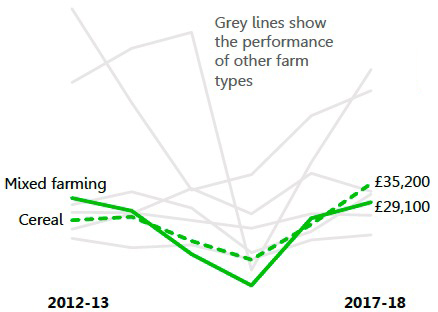Scottish farm business income: annual estimates 2017-2018
This analysis is based on the March 2019 published statistics for the period 2017-2018. Revisions have been made to correct for a processing error affecting these estimates. Revised 2017-18 data is available in the Scottish farm business income: annual estimates 2018-19 publication. For the most recent data, visit the Scottish farm business income (FBI) collection page below.
This document is part of a collection
…cereal farms have performed better this year

We have grouped a number of farm types together included cereal and mixed farming and called them ‘mid-income’. They have a higher average income but also greater fluctuations in performance over time.
Mixed farms usually engage in complimentary activities like growing crops to feed their cattle.
£29,000 to £35,200 Average range of mid-income farms
Mid-income farms in general have performed better this year. Cereal farms have risen to a six year high with average income at £35,200.
Some farm types in this mid-income group still rely on subsidies. Combined cattle and sheep LFA farms received on average £59,000, which is £21,100 higher than the next highest subsidised group which is mixed farming.
Cereal farms without subsidies had a positive income of an average £1,300 per annum. Whereas combined cattle and sheep LFA farms were making a loss of £26,300 without subsidies.
Lowland cattle and sheep farms are also categorised as mid-income.
Contact
Email: agric.stats@gov.scot
There is a problem
Thanks for your feedback